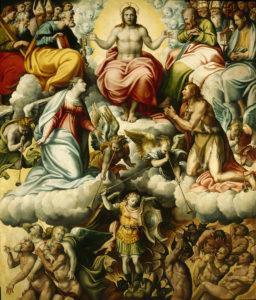Object of the Month: November 2015
The Last Judgment
Oil on panel
Giovanni Filippo Criscuolo (attr. to)
Neapolitan, c. 1495–1584
Click on the links throughout the article to view additional artists’ works and reference material.
This theatrical scene of the last judgment attributed to the sixteenth-century painter Giovanni Filippo Criscuolo beautifully illustrates the era’s emerging artistic trends. Although his hometown of Naples would remain artistically provincial well into the seventeenth century, Criscuolo’s travels to Rome broadened his perspective. Inspired by the art of Michelangelo and Raphael, Criscuolo’s work reflects a more progressive style. For example, the colors, poses, and compositional technique are similar to Michelangelo’s Sistine Chapel frescos.
Criscuolo’s interpretation of the spirit world is also intriguing. Two Medieval literary works influencing renderings like this one were Thomas Aquinas’ Summa Theologica and Dante’s Divine Comedy.
In Summa Theologica, Aquinas organizes the spirit world into specific ranks (or choirs). Those in the first rank (solely dedicated to face-to-face worship of God) are often pictured as disembodied spirits, “pure thought,” like those surrounding Christ’s throne in Criscuolo’s painting. The second rank dedicated to knowing God through contemplation of the universe are here pictured beside Mary and John the Baptist in the midpoint of his canvas. The third rank comprised of angelic messengers who interact in human affairs, are represented in the lower register by the archangel Michael and Satan and their minions. In addition, the wings of the satanic beings are much like those described by Dante: No feathers did they bear but as of a bat/ Their fashion was . . . (Inferno, Canto 34).
As Renaissance artists became increasingly dedicated to bringing the heavens down to earth, angels become more recognizably human; their wings, faces, and bodies sculpted in beautiful detail. By the nineteenth century, such differentiations between the earthly and the heavenly had all but disappeared.
Donnalynn Hess, Director of Education
Published in 2015
